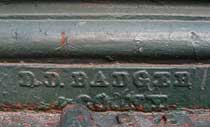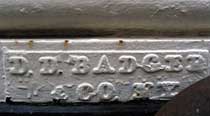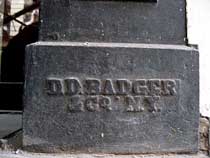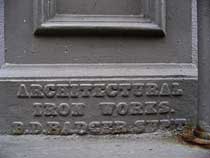

 D. D. Badger & Co., 36 Walker St., New York, 2009
D. D. Badger & Co., 36 Walker St., New York, 2009

The New York Times obituary (19 Nov. 1884, p. 2) for Daniel D. Badger (1806-1884) reads in part, "Daniel D. Badger, the pioneer of this country in the use of iron for building purposes, died at his home, No. 191 Putnam-avenue, Brooklyn, on Monday... Mr. Badger was born on Badger's Island, which lies between Portsmouth, N. H., and the Portsmouth Navy Yard, Oct. 15, 1806. His father was a shipbuilder, but Daniel, having no particular inclination for this trade, as soon as the little education within his reach was obtained, went to work at the forge in a blacksmith's shop in Portsmouth. Here he remained for a few years, when he deserted the forge and went to Woburn, Mass., where he established himself as a manufacturer of saws. He prospered in this business for some years and accumulated a moderate fortune, when a fire destroyed his factory. He then removed to Boston, where he established a foundry for the manufacture of wrought iron in all its different branches. In this business he was very successful and soon became very wealthy. In the meantime his attention had been called to the advantages presented by iron as a building material, and after studying the subject thoroughly he became convinced that iron could be used to as much advantage in constructing the exterior of structures as in the interior. In 1842 he erected the first iron building in Boston, and it is believed to have been the first in the world. The lower story of this structure was composed of columns and lintels entirely of iron, and so great was the fear of the success of the undertaking that Mr. Badger, before beginning the work, was obliged to guarantee that if it proved a failure he would remove the iron work and substitute other material at his own expense. The work proved a grand success, however, and since then iron buildings have multiplied all over the world.
"Mr. Badger soon found that his Boston factory was too small for the work that was forced upon him, and he came to this city and established a factory at Nos. 42, 44, and 46 Duane-street. Subsequently he erected a large establishment, extending from Thirteenth to Fourteen street and from Avenue B to Avenue C, in which he had every department of his business provided for, from the foundry to the pattern shops and architectural rooms. The business of erecting iron buildings has grown to such extensive proportions that Mr. Badger felt unequal to the task of managing it alone, and a company was formed under the title of the Architectural Iron Works, of which Mr. Badger was the President. This company constructed iron buildings in this city, Chicago, Milwaukee, St. Louis, New-Orleans, and in nearly every city of any size throughout the United States, in Egypt and in Cuba. In 1873 Mr. Badger finally retired from active business life, and since then he had resided in Brooklyn. Among the many iron structures in this city which were erected under Mr. Badger's direction are the Grand Central Station, on which he had 1,500 men employed; the old Gilsey Building, at Broadway and Cortlandt-street, and the Manhattan Market, which was subsequently destroyed by fire."
Margot Gayle, writing in Cast-Iron Architecture in New York: a Photographic Survey (1974), says of Badger, "According to his obituary in the New York Times of November 18, 1884, he experimented as early as 1842 with an iron store front on the ground floor of a building otherwise of masonry. It was the first in Boston, although the same sort of construction had been employed in New York even earlier, as evidenced by an ad for a brick building 'with heavy iron columns and lintel and shutters' that appeared in the New York Commercial Advertiser for August 15th, 1836...
"[Badger] went on to great success after he came to New York in 1848. His first small foundry was at 42 Duane St., diagonally opposite Bogardus' conspicuous all-iron factory. Badger's first specialty was iron rolling shutters. He went on to fabricate elements for the increasingly popular iron fronts. By 1854 he had expanded to a site on East 14th St., between Avenues B and C, where his ever-growing great iron works turned out some of the most dramatic iron buildings this country has ever seen."
The same author, writing with Carol Gayle in Cast-iron architecture in America: the significance of James Bogardus (1998), says of Badger, "The enterprising Daniel Badger, one of the pioneers of iron construction, adapted quickly and very successfully to the new era and became one of the leaders in architectural iron. He built his first full iron front in 1853 in New York City and soon was a major constructor of cast-iron buildings, including the big Gilsey office building on lower Broadway (1853-4) and the handsome Cary Building (1856). In 1856 Badger erected the Haughwout Building, a fine example of cast-iron architecture, which still stands at the corner of Broadway and Broome Street in Manhattan... Badger's foundry employed one hundred twenty-five men at an average wage of $44 a month, and twenty-five boys at $16 a month, according to the 1855 economic census. His firm, which took the name Architectural Iron Works in 1856, was among the best known of the cast-iron producers and it has remained so, largely because of the wide renown of Badger's large-format sales book of 1865. Entitled Illustrations of Iron Architecture, it reproduced page after page of sizeable engravings of designs for multistory iron fronts, warehouses, factories, grain elevators and bridges, often with identification of location and architect." (Click for 2011 image of the Haughwout Building, which is being maintained in excellent condition at Broadway and Broome St.)
In 1860 the Architectural Iron Works were recorded in the U. S. Census (non-population schedules for manufacturers) when they employed 400 men at an average monthly labor cost of $12,000. They held approximately $53,000 of raw materials consisting of 400 to 500 tons of pig iron, 1000 tons of wrought iron, and 2200 tons of coal. Annual production of 400 to 500 tons of building iron was valued at $500,000.
The Architectural Iron Works were described as follows in J. Leander Bishop,
A History of American Manufacturers from 1608 to 1860, 1868,
"The Architectural Iron Works were incorporated, in 1856, by D. D. Badger, John M.
Reed, Nathaniel Cheney and others, and re-chartered in 1866. Its present officers
are: D. D. Badger, President; Nathaniel Cheney, Vice-President and Treasurer; and
C. C. Gordon, Secretary.
"In April, 1864, the principal buildings were destroyed by
fire, but the works were immediately rebuilt and improved, and such additions were
made as experience had shown to be needful.
"This establishment has an immense
stock of patterns, trained and skilful workmen, and every facility for the manufacture
of Architectural Iron Work, and, indeed, for the production of a great variety of Cast
and Wrought Iron, including many kinds of machines. It has peculiar, novel and
ingenious machines for the making of Iron Venetian Blinds, Iron Lathing, and Fire
and Burglar-proof Iron Rolling Shutters.
"In past years, it has been largely engaged in making shot and shell of all sizes,
projectiles and gun-carriage, for the use of our own Government, and also for foreign
powers. The largest Gun-carriages constructed were for twenty-inch guns.
"It would require a large space to enumerate all the used to which iron has been
applied by the Architectural Iron Works, but the following may be mentioned, viz.:
Iron Store Fronts, Manufactories, Grain Warehouses, Arsenals, Ferry Houses, Bridges,
Roofs, Domes, Rolling Shutters, Venetian Blinds, Wrought Sashes, Railings, Verandahs,
Balustrades, Cornices, Stairways, Columns, Capitals, Arches, Window Lintels and Sills,
Consoles, Brackets, Rosettes, Urns, Door and Window Guards, Lamps, Awning and Horse
Posts, Girders, Beams, Patent Lights and Iron Sidewalks. Specimens of the work of
this Company abound in the city of New York, and may be found in all the principal
cities and towns of the United States, and even in foreign places - Havana, Matanzas,
Halifax, N. S., Rio Janeiro, Aspinwall, Alexandria, Egypt, etc.
"Among the largest buildings erected by this Company, may be mentioned the
Congressional Library, Washington, D. C.; the Grain Warehouses of the United States
Warehousing Company, Brooklyn; and of the Pennsylvania central Railroad Company at
Philadelphia; the Iron Ferry Houses of the Union Ferry Company at Fulton and Whitehall
Ferries; the King's County Court House, and Halsey Buildings, Brooklyn; Cary's Building,
Gilsey's Building, Houghwaut's Building; and the Singer Manufactory in the city of
New York; the United States Arsenal at Watervliet, N. Y., and several blocks of
five-story Iron stores in Chicago.
"In this connection, a brief memoir of the President of this Company, and the
Pioneer in Iron Architecture in America, may not be inappropriate.
"Daniel D. Badger was born in Portsmouth, New Hampshire, in 1806, and, during
youth, was employed in working iron in his native town. In 1829, he removed to Boston,
and commenced business as an iron founder. In the year 1840, he erected, in Washington
street, Boston, the first Iron front ever seen in America; but so great was the
prejudice against his enterprise, that he was compelled to give a guarantee that,
if it should prove a failure, he would remove it as his own expense. The columns
and lintels of this building were of iron.
"About this time, A. L. Johnson, Esq., of Baltimore, invented and patented Rolling
Iron Shutters. Mr. Badger purchased the patent, and introduced the shutters into his
new structures. His Iron Fronts (known as 'Badger Fronts') came slowly into favor.
"In 1846, he came to New York, and was associated with Charles Reed, Esq., in
the prosecution of his business. Here, he found the Builders, the Fire Department,
and the Fire Insurance Companies, all violently opposed to his innovation. He
struggled against objections of the most diverse character, but, steadily persisting
in his purpose, ultimately overcame all obstacles, and established the use of Iron as a
leading building material. Structures for mercantile and mechanical purposes, having
open fronts and large show windows, began to supplant the former cumbrous and ill-lighted
warehouses, and their superiority was too obvious to be denied. The first buildings
erected by Mr. Badger were, by many, regarded as experiments; but, from the outset,
he was sanguine that they would receive the public approval; hence he prosecuted the
business, for a series of years, with untiring industry, enterprise and persistence,
and almost without a competitor.
"All the Iron buildings that now adorn our great cities owe their existence to the
humble introduction of iron, as an external building material, in Boston, in 1840; and
we believe Mr. Badger may be fairly regarded as the originator, inventor and pioneer
of Iron Architecture in America."
D. D. Badger is listed in Trow's New York city directories from 1848 through 1873. The foundries at 624 E. 14th St. continue from 1852 to 1878. This ad appeared in Trow's New York city directory in 1876.
Sarah Bradford Landau and Carl W. Condit, writing in Rise of the New York Skyscraper, 1865-1913 (1996), identify Badger as the source of the iron for the Gilsey Building (c.1854; now demolished), located at Broadway and Cortlandt St.: "The iron fabricator was Daniel D. Badger, who in 1846 had established a business that was later known as the Architectural Iron Works of New York, which became one of the country's major iron foundries. Badger was also responsible for the ground floor exterior ironwork of the section added to the A. T. Stewart Store in 1852-53, as well as the iron fabrication of the elegantly Venetianesque Haughwout Building." The same authors note that Badger's Architectural Iron Works supplied the iron used in the Cooper Union building on Astor Place (1853-59), and the Gilsey House (1869-71) on Broadway at W. 29th St.
Daniel Badger is buried in Green-Wood Cemetery, Brooklyn. The inscription on his grave marker reads "Daniel D Badger / born Oct 20, 1806 / Died Nov 17, 1884."
Many additional founder's marks for D. D. Badger can be found in New York City, including

116 Duane St |

75 Worth St. |

579-581 Broadway |

103-107 Reade St. |
Margot Gayle, writing about 90 Maiden Lane in Cast-Iron Architecture in New York (1974), p. 4, notes that "The iron castings were made in the famous foundry of Daniel D. Badger, whose trademark, 'Architectural Iron Works, NY,' is barely legible through layers of paint at the bases of the four piers of rusticated quoins." (Click for image.)
The mark at 103-107 Reade St. reads "Architectural / Iron Works / D. D. Badger, Sup't." A photograph of this same founder's mark is shown in Cast-iron architecture in America: the significance of James Bogardus, by Margot Gayle and Carol Gayle (1998), p. 157.
Daniel Badger's Architectural Iron Works at 42 Duane St. are shown in this illustration from the firm's 1865 catalog. Badger's catalog is available in reprint editions, and contains renderings of several prominent New York buildings. A detail from one of the plates shows the first two floors of the Cary Building, 105-107 Chambers St. and 89-91 Reade St. My own photographic rendering from Jan. 2009 seems pale in comparison. The catalog lists hundreds of buildings in New York for which Badger supplied the cast-iron. The foundry mark still exists at 49 Murray St., described in the catalog simply as 1 Store Front. Others remain at 113 Chambers St. and 74 Reade St.

The entrance way at 179 Church St. indicates that Badger was located at 42 Duane St.
when this was cast. Badger had either a foundry or offices at this address from approx.
1848 to 1867.
Copyright © 2009 Walter Grutchfield